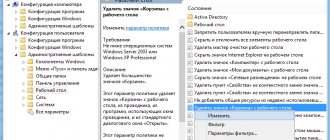Sometimes the user is not satisfied with the size of standard Windows interface elements. Some parameters can be changed using standard OS tools, and you can completely customize the desktop grid using a third-party program. Today we will talk about how to make small icons on the Windows 10 desktop. With compact icons and minimal space between them, you can fit more folders and applications. In addition to ways to change the size of shortcuts, the ability to adjust the intervals between them will be affected, as well as changing the size of icons from the taskbar.
Context menu
The following method allows you to choose between three standard icon sizes. To do this, right-click on the screen and expand the “View” list. Here you will see three scale options (regular, large and small icons). The default is normal size. Try using large and small icons.
If you were careful when adjusting the icon scale, you will notice that the text size and spacing between labels remain the same. You can change these parameters using third-party tools.
Change the size of Windows 10 taskbar icons
Windows developers have provided a minimal selection of tools for changing the size of icons on the Taskbar. Right-click on the panel and activate “Taskbar Options”.
Enable or disable the option for small or large buttons. For a computer with a small display, I recommend activating automatic hiding of the taskbar. This will allow, albeit slightly, to increase the working area of the screen in applications.
Wider icon size scaling is only available using system methods. This will automatically change the size of all Windows interface elements. Open “Display Settings” by right-clicking on the desktop.
In the “Menu and Layout” section, you can select a preset option for the size of system elements, or set the parameters manually.
To configure it yourself, open the “Advanced Scaling Options” window, enter a size in the range from 100% to 500% and click “Apply”.
For the changes to take effect, you must reboot the system. Please note that too large a size affects the display quality of elements of the entire system and depends on the capabilities of the display and video adapter. In this case, rolling back the previous settings will be quite problematic.
See also: Desktop disappeared in Windows 10 - solutions.
Hotkeys
The next method involves using hotkey combinations. You can set 4 types of size using the keyboard. You need to hold down ++ to make the icons very large. This option, by the way, is not in the context menu mentioned earlier.
Other combinations involve the keys , , - these are large, regular and small icons, respectively.
Scaling Windows 10 Desktop Elements
Typically, users are interested in icons on the “Desktop”, as well as icons and buttons on the “Taskbar”. Let's start with the first option.
Stage 1: “Desktop”
- Move the cursor over an empty space of the “Desktop” and call up the context menu, in which use the “View” item.
This item is also responsible for changing the size of the Desktop elements - the “Large Icons” option is the largest available.
System icons and user shortcuts will increase accordingly.
This method is the simplest, but also the most limited: only 3 sizes are available, to which not all icons respond. An alternative to this solution would be to change the scale in Display Settings.
- Right-click on the “Desktop”. A menu will appear where you should use the “Display Options” section.
- TOP 8 useful and necessary programs for Windows 10
Scroll down the list of options to the “Scale and Layout” block. The available options allow you to adjust the screen resolution and scaling within limited settings. If these options are not enough, use the "Advanced scaling options" link. The “Fix scaling in applications” option allows you to eliminate the problem of a blurry picture, which makes it difficult to perceive information from the screen. The “Custom Scaling” function is more interesting, because it allows you to choose an arbitrary image scale that is comfortable for you - just enter the desired value in the text field in the range from 100 to 500% and use the “Apply” button. However, it is worth considering that non-standard magnification may affect the display of third-party programs.
However, this method is not without its drawbacks: a comfortable value for arbitrary magnification has to be selected by eye. The most convenient option for increasing the elements of the main workspace would be the following:
- Move the cursor over an empty space, then hold down the Ctrl key.
- Use the mouse wheel to set a custom scale.
Using this method, you can select the appropriate size for the icons in the main workspace of Windows 10.
Stage 2: "Taskbar"
Scaling the taskbar buttons and icons is a little more difficult, since it is limited to enabling one option in the settings.
- Move the cursor over the “Taskbar”, right-click and select the “Taskbar Settings” item.
- Find the “Use small taskbar buttons” option and disable it if the switch is in the activated state.
- Typically, these settings are applied immediately, but sometimes you may need to restart the computer to save the changes. Another method for enlarging the “Taskbar” icons is to use the scaling described in the option for
“Desktop”. We have reviewed methods for enlarging icons on the Windows 10 Desktop. We are glad that we were able to help you solve the problem. Describe what didn't work for you. Our specialists will try to answer as quickly as possible.
Did this article help you?
Registry Editor
We recommend this option only to experienced users, since it involves interfering with the Windows registry. Before doing this, create a restore point to restore all settings if problems arise. If you make incorrect changes to the registry settings, you may experience serious system failures. So let's start editing:
- Launch Registry Editor. Enter regedit in the search bar and open the application of the same name.
- Using the directory tree, open the branch shown in the screenshot below.
- Find the IconSize parameter. Open properties by double clicking the mouse.
- Here you need to enter a new parameter. You can set an arbitrary value and check the result. The changes will take effect after you restart File Explorer, your Windows account, or your computer.
If you want to change the size to one of the standard ones, then specify the value 100, 60, 30 or 20 - these are extra large, large, regular and small labels.
Changing the size of icons in Windows 10 Explorer
In the Explorer interface, just like on the desktop, there are several ways to adjust the size of elements. All the same tools are suitable for this as in the case of the Desktop. There are additional options in the View context menu. For example, the “Huge Icons” option is suitable for previewing graphic files. The “Table” option is convenient for sorting a large number of files by additional parameters.
Changes you make to the order in which items are displayed in Explorer only apply to the current folder. If you want the settings you select to apply to all folders, you need to follow some additional configuration steps. In the application context menu, select “View”, then “Options” and in the “View” tab click “Apply to folders”.
You must restart your computer for the changes to take effect. Setting up display in system folders will have to be done separately.
Winaero Tweaker utility
If you want to adjust the spacing between icons and the size of captions, then use the Winaero Tweaker utility. You can download it from the provided link. After installation, run the program and do the following:
- Go to the Advanced Appearance Settings section.
- Now switch to the Icons item.
- On the right side of the window, you can select the size of Horizontal spacing and Vertical spacing - this is the horizontal and vertical distance between desktop icons.
- In the Change icons sample item, click on the Change font button.
- In the window that opens, change the font style and size if necessary.
- To save the settings, click Apply changes.
Expert opinion
Basil
Project manager, comment moderation expert.
Ask a Question
Changes will take effect only after restarting your account, Explorer or computer.
How to change icon size in different ways
How can I change the size of desktop icons in Windows 10? There are several approaches to the problem.
Via context menu
It belongs to the OS tools, allows you to carry out some improvements in characteristics and perform various operations with objects. To enlarge or reduce icons, the following algorithm is required:
- The cursor is placed in any free space on the desktop.
- Right-click and examine the list of secondary capabilities displayed on the display.
- Click on the “view” block.
- At the top of the list, select the desired label format.
The usual ones are medium in size; to reduce the size, select the inscription “small”; to increase the size, select “large”.
Settings are adjusted instantly. If the user is not satisfied with the result obtained, he can change the values at any time. There are no restrictions on this type of operation.
Via context menu
Via the registry
The file registry editor is a built-in tool in the Windows OS. He can work with the shells of various elements, sections on a laptop or desktop computer.
The technique is used when all other methods give an error or are unavailable for execution. The process of changing icon size in Windows 10 is carried out in stages:
- Using a combination of the “Win” and “R” hotkeys, an additional “Run” window is launched.
- The command “regedit” is written in an empty line, the action is confirmed by “enter” or “ok”.
- After opening another window, you need to go through the path: “Computer - Hkey_Current_User - Software - Microsoft - Windows - Shell - Bags - 1 - Desktop”.
- On the right side, click on the “IconSize” block.
- To add large volumes to labels, you need to enter “100” in the “value” line and confirm the action; regular sizes require the inscription “30”, and minimum sizes require the last inscription that appears on the display.
- For the adjustment to take effect, the computer is forced to restart.
To work with this section, primary skills and attentiveness are required.
If incorrect characteristics are specified during the process or another block is selected by mistake, serious damage to the operating system shell can be caused. Such actions will provoke errors and failures that are difficult to correct.
To avoid having to completely reinstall the OS, you need to create an additional restore point before entering the registry. In this case, the personal computer will be able to return to its original state.
Using the registry
Using "Options"
Changing the size of Windows 10 shortcuts is done through the specified editing section. This subsection allows for improvements in external and internal data to suit user priorities.
The following algorithm is performed:
- On the desktop, in any free space, you need to right-click.
- In the list that appears, select “screen settings” among the additional functionality.
- On the left side there is a “display” block, on the right you need to find the “layout and scale” subsection.
- The monitor will display several characteristics - changing the size of pictures, symbols, text, etc., choosing the orientation and appropriate resolution.
- If the set parameters are too large, then they can be reduced by decreasing the percentage; in the reverse order, they can be made to increase.
- Improvements will appear after clicking “ok” - the user can sequentially change the characteristics until the expected result is obtained.
The tenth version of the OS allows you to change various parameters to adjust the operation of a personal computer, both desktop and portable, to suit your personal needs. The scaling instructions are simple and easy for any beginner to follow.
It’s also not difficult to change the parameters
Task bar
There are even fewer options for changing the size of shortcuts in the Taskbar than on a desktop.
1. Right-click on its interface and select “Options...”.
2. Move the “Use small buttons...” switch to change the height of the panel and enable small icons on it.
Icons can be enlarged, but the scaling will also affect other elements of the Windows 10 interface.
3. Open “Display Settings” through the Desktop context menu.
4. In the "Scale and Layout" section, change the value or enter it manually.
The settings take effect after you restart your computer or log out of your account.
Desktop icons
Solving this problem is as easy as shelling pears: even someone who has never used a computer can cope with the task. The bottom line is this:
- You need to right-click on the free space of the table.
- Find “View” in the list (in most cases it is at the very top).
- Click on one of three possible options.
This method is the most well-known and popular, but it does not allow you to change the size of images at your discretion. If you want to select any other size, then you should hold down the Ctrl key, and then simply start rotating the mouse wheel. In this case, you can immediately notice how the icons begin to get smaller or bigger. You can also make up and down movements using the touchpad.
You can change the size to standard in the very first way. The default option is “Regular”.
Changing the size of icons using the keyboard and mouse
First, we'll look at how to change Windows 10 desktop icons using the mouse wheel. To do this you need to do the following:
- Go to the main desktop, hold down the + key combination and roll the mouse wheel up: this will enlarge all the desktop icons. If you turn the wheel down, the icons become smaller.
As you can see, this method is not so complicated and you can try it right away. And if you don’t want to spin the wheel, then there is another option: using the context menu. To implement this method, do the following:
- Right-click on the desktop. In the window that appears, go to “View” . Then choose what size icons you want to install.
There is nothing complicated about replacing icons: just follow all the recommendations and you will achieve the desired result.











